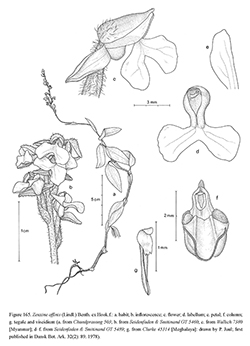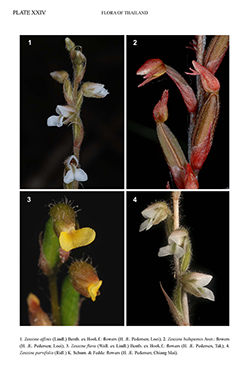e-Flora of Thailand
Volume 12 > Part 1 > Year 2011 > Page 283 > Orchidaceae > Zeuxine
1. Zeuxine affinis (Lindl.) Benth. ex Hook.f.
Fl. Brit. India 6: 108, 1890; Seidenf., Dansk Bot. Ark. 32(2): 88, fig. 55. 1978; Opera Bot. 114: 37, t. IIId. 1992; Seidenf. & J.J.Wood, Orchids Penins. Malays. Singap.: 89, fig. 34h–n, t. 2c. 1992; Thaithong, Thai Orchids [in Thai]: 72. 2000; N.Pearce & P.J.Cribb, Fl. Bhutan 3(3): 110. 2002; Chantanaorr. & Thaithong in H. Nair & Arditti (eds), Proc. 17th World Orchid Conf.: 148. 2005; Sitthisajjadham, Wild Orchids Thail. [in Thai]: 466. 2006; S.C.Chen et al. in Z.Y. Wu et al. (eds), Fl. China 25: 75. 2009.— Monochilus affine Lindl., Gen. Sp. Orchid. Pl.: 487. 1840 (p.p.). Fig. 165; Plate XXIV: 1.
Accepted Name : This is currently accepted.
Synonyms & Citations :
Description : Flowering shoots (6–)10–35 cm tall. Foliage leaves petiolate, (greyish-)green above, dull light green underneath; lamina linear-lanceolate to ovate-lanceolate, acute, (1–)1.3–4.4 by (0.4–)0.5–1.7 cm. Inflorescence pubescent; rachis (1–)1.2–8.3(–12) cm long; bracts lanceolate to ovate, acuminate to cuspidate, pubescent on the dorsal side, 3.7–10.9 by 2.3–4.1 mm. Flowers (sub)sessile, mainly (brownish- to pinkish-)green (petals and labellum white, sometimes with a green or yellow blotch on the epichile). Sepals 3-to 5-veined, pubescent on the dorsal side (rarely subglabrous); dorsal sepal lanceolate-oblong to ovate, rounded to obtuse, 4.5–9 by 2.7–4.7 mm; lateral sepals obliquely (elliptic-)oblong to (ovate-lanceolate, rounded to subacute, 3.8–7.1 by 1.7–3.4 mm. Petals adherent to the dorsal sepal, obliquely lanceolate-oblong to elliptic, not abruptly narrowed below the apex, 4.3–8.5 by 1.6–3.1 mm. Labellum 3.7–7.5 mm long along the mid-line; hypochile inside with 1 papilla-like appendage on either side; mesochile smooth on the outside: epichile bilobed, with a distinct V-shaped sinus at apex when spread out distinctly wider than the hypochile, lobules (obtriangular-)obovate to subcircular, 2.1–7.1 by 1.6–4.8 mm (length measured along the hind edge), 1.1–2.4 times as long as wide. Column devoid of ornaments on the front or with 2 vertical keels that are sometimes abruptly protruding just below the rostellum. Ovary pubescent. Capsule erect, (sub)sessile, oblongoid, (sparsely) pubescent, 0.7–1.3 cm long, 0.3–0.5 cm in diameter.
Thailand : NORTHERN: Mae Hong Son, Chiang Mai, Sukhothai (Ramkhamhaeng), Phitsanulok (Phu Miang); NORTH-EASTERN: Phetchabun, Loei, Sakon Nakhon (Phu Phan), Khon Kaen (Pong canal); EASTERN: Nakhon Ratchasima; SOUTH-WESTERN: Kanchanaburi; Prachuap Khiri Khan (Huai Yang); CENTRAL: Nakhon Nayok (Khao Yai); SOUTH-EASTERN: Chanthaburi (Phlio Falls), Trat; PENINSULAR: Ranong (Khao Phota Luang Kaeo), Surat Thani (W of Khao Tha Phet), Krabi (Khao Phanom Bencha), Nakhon Si Thammarat, Satun.
Distribution : India, Bhutan, Bangladesh, Myanmar (type), S China, Laos, Vietnam, Peninsular Malaysia, Taiwan.
Ecology : Humus-rich ground in tropical rain forests, seasonal evergreen forests, hill evergreen forests, mixed deciduous forests, open scrub and bamboo thickets, mainly on granite or sandstone bedrock: 20–1,600 m alt. Flowering: mainly November–March, but also recorded in April, July and October.
Vernacular : Ueang nuan chan (เอื้องนวลจันทร์)(Northern).
Notes: When Seidenfaden (1978) described Zeuxine grandis, he noticed that it looked “very much like a large-flowered form of Z. affinis”, but he also found the study material to fall in “two well separated groups”. He therefore preferred to consider the large-flowered form a separate species. I have re-measured all specimens of Z. affinis s.s. and Z. grandis previously annotated by Seidenfaden (but not necessarily the same flowers). Although the complex is highly variable with regard to flower size, two distinct groups of specimens could not be recognized. On the contrary, a broad overlap was found in all characters scored. For example, the lobules of the epichile (emphasized in Seidenfaden’s key) were found to measure 2.1–5.3 by 1.6–3.8 mm in material previously identified as Z. affinis s.s. and 3.2–7.1 by 1.9–4.8 mm in material identified as Z. grandis. I also found variation in other putative distinguishing characters such as the angle between the epichile lobules, the morphology and insertion of calli in the hypochile and the presence versus absence of vertical keels on the front of the column; but variation in different characters appeared to be uncorrelated. In conclusion, I propose that Z. grandis is better treated as a synonym of Z. affinis.
Pearce & Cribb (2002) included Thailand in the distribution area of the doubtfully distinct Zeuxine reflexa King & Pantl. However, I have seen no Thai material annotated as Z. reflexa.


